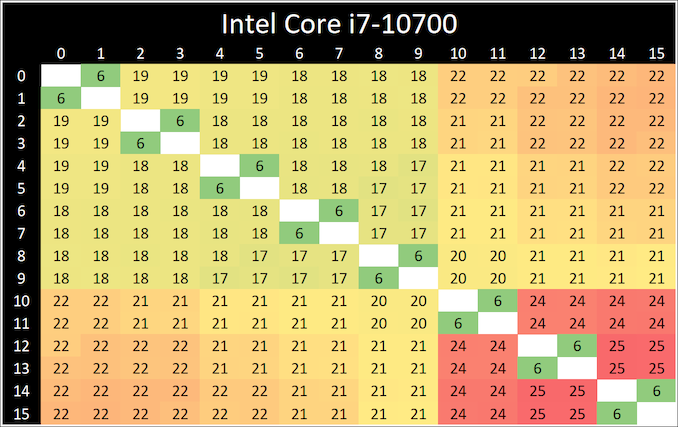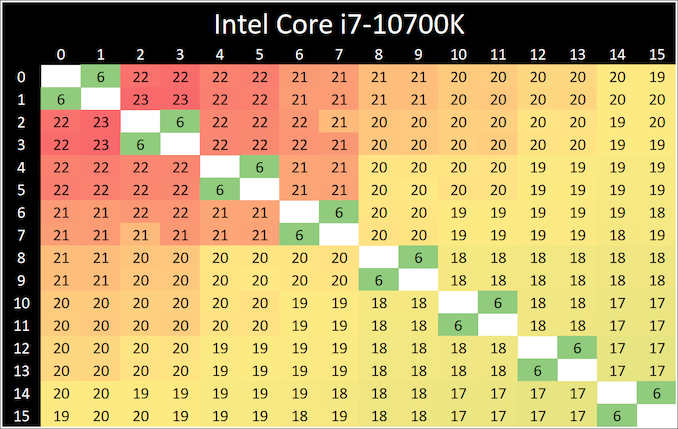Intel Core i7-10700 vs Core i7-10700K Review: Is 65W Comet Lake an Option?
by Dr. Ian Cutress on January 21, 2021 10:30 AM EST- Posted in
- CPUs
- Intel
- Core i7
- Z490
- 10th Gen Core
- Comet Lake
- i7-10700K
- i7-10700
CPU Tests: Microbenchmarks
Core-to-Core Latency
As the core count of modern CPUs is growing, we are reaching a time when the time to access each core from a different core is no longer a constant. Even before the advent of heterogeneous SoC designs, processors built on large rings or meshes can have different latencies to access the nearest core compared to the furthest core. This rings true especially in multi-socket server environments.
But modern CPUs, even desktop and consumer CPUs, can have variable access latency to get to another core. For example, in the first generation Threadripper CPUs, we had four chips on the package, each with 8 threads, and each with a different core-to-core latency depending on if it was on-die or off-die. This gets more complex with products like Lakefield, which has two different communication buses depending on which core is talking to which.
If you are a regular reader of AnandTech’s CPU reviews, you will recognize our Core-to-Core latency test. It’s a great way to show exactly how groups of cores are laid out on the silicon. This is a custom in-house test built by Andrei, and we know there are competing tests out there, but we feel ours is the most accurate to how quick an access between two cores can happen.
When we first reviewed the 10-core Comet Lake processors, we noticed that a core (or two) seemed to take slightly longer to ping/pong than the others. These two parts are both derived from the 10-core silicon but with two cores disabled, and we still see a pattern of some cores having additional latency. The ring on the 8-core parts still acts like a 10-core ring, but it all depends on which cores were disabled.
Frequency Ramping
Both AMD and Intel over the past few years have introduced features to their processors that speed up the time from when a CPU moves from idle into a high powered state. The effect of this means that users can get peak performance quicker, but the biggest knock-on effect for this is with battery life in mobile devices, especially if a system can turbo up quick and turbo down quick, ensuring that it stays in the lowest and most efficient power state for as long as possible.
Intel’s technology is called SpeedShift, although SpeedShift was not enabled until Skylake.
One of the issues though with this technology is that sometimes the adjustments in frequency can be so fast, software cannot detect them. If the frequency is changing on the order of microseconds, but your software is only probing frequency in milliseconds (or seconds), then quick changes will be missed. Not only that, as an observer probing the frequency, you could be affecting the actual turbo performance. When the CPU is changing frequency, it essentially has to pause all compute while it aligns the frequency rate of the whole core.
We wrote an extensive review analysis piece on this, called ‘Reaching for Turbo: Aligning Perception with AMD’s Frequency Metrics’, due to an issue where users were not observing the peak turbo speeds for AMD’s processors.
We got around the issue by making the frequency probing the workload causing the turbo. The software is able to detect frequency adjustments on a microsecond scale, so we can see how well a system can get to those boost frequencies. Our Frequency Ramp tool has already been in use in a number of reviews.
Both processors ramp from idle to full turbo in about six milliseconds, well within a single frame of standard gaming.













210 Comments
View All Comments
magreen - Friday, January 22, 2021 - link
Man Spunji, you are diligent. I was just going to ignore the obvious trollSpunjji - Monday, January 25, 2021 - link
It's a sensible policy - I just like debunking FUD 👍bji - Thursday, January 21, 2021 - link
Ryzen 5 5600x at $299 is a lie right now than and has been for months. It's slowly coming down to $399 with general availability. It will be months before it's actually available at $299.Please no one respond with stories of one-off deals that they happened to get from some rare and hard to find vendor, where the deal was only available for 10 minutes anyway.
The simple fact is that no Ryzen 3 processors have had general availability at anywhere near MSRP for months.
Golgatha777 - Thursday, January 21, 2021 - link
I've personally purchased 2 5600X and 1 5800X for MSRP at Micro Center?bji - Thursday, January 21, 2021 - link
Micro Center is not "general availability" given that it's only accessible to a few million people who happen to be within driving distance of one of their stores so, you fail.silverblue - Thursday, January 21, 2021 - link
Well... one stockist (OCUK) in the UK has had the 5600X at £279 for at least the past 24 hours, whereas the average on Google seems to be about £310 to £320. Your mileage may obviously vary, I suppose.bji - Thursday, January 21, 2021 - link
The US MSRP is $299 which is 218 British Pounds. So the numbers you quote indicate a significant reseller mark-up which makes my point. So thanks for agreeing with me.I wouldn't mind paying AMD a fair price ($399 apparently) for a 5600X, but I will NOT give $100 or more to scalpers. AMD will use my money to make me more of what I want (faster chips). Scalpers will use my money to just scalp me harder in the future. I will never buy a scalped product.
And so I continue to wait and wait to build a 5600X/RTX3080 gaming PC ... been waiting for months now ...
Calin - Friday, January 22, 2021 - link
I think the UK price indicate about 20% of Value Added Tax - which is paid directly at the moment of sale. If I remember correctly, US prices do not contain "State Tax" and the like.silverblue - Sunday, January 24, 2021 - link
Exactly. Aside of any delivery costs from retailer to customer, we pay what's written on the price tag. That $299 isn't looking so cheap now. Funnily, the current conversion from dollars to pounds means a near 1:1 for comparison.jimbo2779 - Friday, January 22, 2021 - link
Everything is more expensive in the UK. Our MSRP is different to yours because of import duties. MSRP is still MSRP just that our MSRP is different from your MSRP.We would not be expecting to be paying US pricing just as we wouldn't expect to pay the going rate in Australia, that is the case for every saleable item.